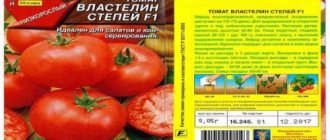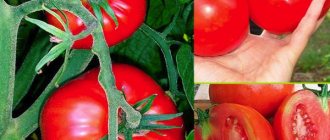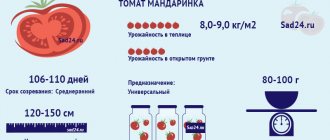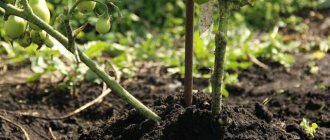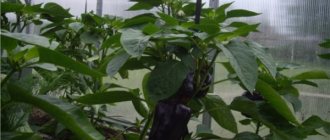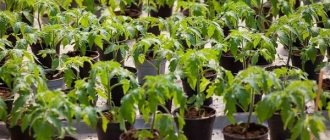Tomato Grozdeva is a bright representative of the group of hybrids with early ripening. It can be grown in open ground (in the southern regions) and greenhouses (in the northern regions). Juicy, tasty and healthy fruits are used to make salads and juices. Gardeners prefer to can them whole to enjoy the memory of summer in winter.
Why is the Grozdevoy F1 hybrid so popular, how to grow it and what similar analogues exist? The article will tell you everything about these tomatoes.
Description, characteristics, yield indicators
The hybrid boasts clusters of fruits that somewhat resemble bunches of grapes. Only tomatoes are much larger and heavier than berries.
The plant has many features:
- the growing season is 100–105 days;
- the bush stretches to 1.8–2.2 m in height;
- the fruits are rich red in color and look like an elongated plum with a slightly pointed tip;
- each cluster produces 8–10 tomatoes;
- weight of tomatoes – from 100 to 120 g;
- yield – 18–21 kg per bush;
- The stability of the harvest and the quality of the fruit do not change for 3-4 years.
Important! The Grozdeva F1 tomato is included in the State Register of the Russian Federation for growing under film covers on private farms.
The hybrid perfectly withstands heat and sudden temperature changes. Marketability and transportability are high. Resistant to nematode, tomato mosaic virus, verticillium and fusarium.
History of variety selection
Tomato Grozdevoy F1 belongs to the first generation hybrid varieties, as indicated by the designation F1 in the name.
This variety is an achievement of Russian breeders from; it was included in the State Register of the Russian Federation in 2010 and is recommended for cultivation under film shelters not only in the central, but also in the northern regions. Cluster F1 belongs to the cluster tomatoes, which are characterized by the setting and ripening of fruits in the form of a cluster. They are more resistant to both diseases and climatic conditions.
This type also includes:
- French grape;
- Black grape;
Video: Tomato variety French bunch
- Siberian grozdevoy.
Advantages and disadvantages
Gardeners prefer to grow the Grozdeva hybrid because of its high yield, beauty and excellent taste of the fruit. The culture is resistant to major types of diseases and infections and is well preserved fresh.
Disadvantages of the variety:
- hybrid seeds need to be bought in a specialized store, they are not so easy to find;
- brushes are formed frequently and in large quantities, which is why tomatoes require a lot of fertilizer;
- The plant is tall, but its stems are weak and lie down under the weight of the fruit.
Attention! Bushes require support and regular garter. They also grow greatly in breadth and height. Timely formation of plants will avoid sad consequences.
Super early tomatoes for polycarbonate greenhouses. The best varieties
Good day everyone!
Tomatoes are one of the most popular garden plants that can be found in any garden plot. Simply put, everyone grows tomatoes. Depending on the conditions and possibilities, gardeners plant seedlings either in open ground or in a greenhouse. There are a number of advantages in open ground compared to a greenhouse. But growing plants in a greenhouse is best for those who want to receive crops all year round, or whose climatic conditions do not allow them to harvest on time.
There are no particular difficulties for growing tomatoes in a greenhouse, but there are some conditions. First of all, it's light. There should be enough light and in the greenhouse light is needed throughout the day. Of course, a necessary greenhouse condition is good ventilation and optimal temperature and humidity.
One of the articles talked about what varieties of large-fruited tomatoes can be grown in greenhouse conditions. Here we will look at varieties of super early tomatoes.
These varieties are intended exclusively for greenhouses. They are characterized by rapid ripening, high yield, small size and, of course, excellent taste.
How to grow
It is better to sow seeds in early March. When the spring season ends, the plant will reach 50–60 days of age and will be ready to be planted in open ground.
Summer residents from warm regions of Russia can plant seeds directly into open ground to a depth of 3-4 cm. Then they should care for the plants as if they were ordinary seedlings.
Attention! It is not recommended to select seed material for further cultivation. Otherwise, the parent plants will lose all their advantages, and the quality and quantity of the harvest will noticeably decrease.
Residents of the northern regions should grow Grozdeva tomato through seedlings. First soak the seeds in a weak solution of manganese and biogrowth stimulator “Epin” strictly according to the instructions. Then prepare the soil mixture:
- you can mix turf soil, humus and sand in a ratio of 6:3:1;
- peat, sawdust and greenhouse soil - in a ratio of 1:1:2;
- add 15–20 g of ammonium nitrate, 50–60 g of superphosphate, 15–20 g of potassium sulfate and a little ash.
The seeds are sown in a container to a depth of 1 cm, covered with polyethylene and placed in a warm place. The room should be warm - from 20 to 24 °C.
Preparing seedlings
After 2-3 true leaves appear, picking is performed. Each plant is placed in a separate container and put in a dark place, otherwise the seedlings will stretch. When the sprouts are well strengthened, the hardening procedure begins: they are moved to a cool room with a temperature of +8°C.
Soil preparation
Rotted manure, humus and sand are added to the place where the tomatoes will be planted. Add 80 g of nitroammophoska and a half-liter jar of ash. Then the bed is dug up.
Planting scheme
There should be a distance of 40–60 cm between the bushes, and 70–100 cm between the rows. When planting, it is necessary to treat the plantings with preparations that contain copper.
Attention! The area should be well lit and windless.
The best predecessors for tomatoes are cabbage, garlic, legumes, cucumbers, onions and carrots.
After planting in the ground, tomatoes are watered after 7 days. In the future, the soil is moistened only as it dries. Water procedures are best performed in the morning or evening.
It is necessary to feed plants with nitrogen, phosphorus, and potassium fertilizers throughout the entire growing season. The first feeding is applied after planting the seedlings in open ground, the second - during the formation of ovaries, the third - during the fruiting period.
Prevention of diseases and pests
Tomato Grozdevoy F1 is resistant to many diseases. But, as practice shows, plants can still die from adverse effects. Main diseases and pests:
- Late blight. A dangerous infectious disease that cannot always be defeated. The fruits become covered with brown rot, the root system dies, and the bush dies. The fungi move to other tomatoes and continue to parasitize. The culture is treated with Profit Gold and Abiga-Peak. Solutions are prepared in accordance with the instructions.
- Aphids and whiteflies. Insects eat leaves and feed on plant juices. They cause significant damage in a short period of time. Plantings may die even before fruiting. Tomatoes are treated with Zubr, Iskra, Zolotoy, Komandor, Apache and other fungicides.
It is important to understand that the best fight against infections and pests is prevention. Activities should begin in late autumn. After harvesting the last harvest, it is necessary to burn the tops of all garden crops, then dig up the soil to a depth of 25–30 cm. This way, insect larvae and fungal spores will appear on the surface, and frost will effectively do its job.
Additionally, greenhouses should be ventilated, plants should not be overwatered, and plantings should not be thickened. Massive greenery attracts various insects, prevents air and light from penetrating through tall bushes - this is where late blight and other diseases can appear.
Productive hybrids Grozdevoy F1 and Kornabel F1
Features of growing the tomato variety Sibirsky grozdevoy
The Siberian grape tomato can grow both in a greenhouse and in open ground. With the right agricultural technology, which does not include complex manipulations, it is possible to harvest an excellent harvest that can be stored for a long time.
Sowing seeds and growing seedlings
Siberian bunch tomatoes are planted in the ground 60 days before they are placed in a permanent bed. In each region, the exact date will be selected individually. In the south, seeds begin to be sown in late February - early March, and in the north - no earlier than April.
A commercial soil mixture for tomatoes and peppers is best suited for tomatoes. If purchasing it is problematic, you can make a mix of equal parts of garden soil, humus, peat and sand. You just need to first calcinate the resulting composition in order to destroy possible microorganisms.
The selected container is half filled with earth. Next, grooves are made on top of it to about 1 depth. Tomato seeds are placed in them, which are then sprinkled with soil residues so that the covering layer does not exceed 1 cm. Watering is done only in a weak stream, which can be obtained using a syringe, sieve or spray bottle. Next, the container is covered with glass or film and placed in a well-lit place with a temperature not lower than +24 °C.
As soon as active growth of tomatoes begins, the shelter is removed, and the box with seedlings is moved to a cooler place with a temperature of +17 °C for about a week. Then he will have to move again - to a room with a temperature of +22 °C. Another important point is the quality of lighting. It must be long lasting. As a rule, there is still very little natural light at the beginning of spring, so additional lighting will be needed with a special lamp.
All this time, as the soil dries, watering is carried out. Its volume and frequency depend on growing conditions and container size. It is important to ensure that the soil does not remain dry for a long time, but moisture stagnation should not be allowed.
Landing in the ground
It is better to prepare the soil in advance and dig it up in the fall along with fertilizers (superphosphates, humus, potassium salt). In the spring, the bed is dug up again. So that the tomatoes take root as best as possible. It is important to follow the rules of crop rotation - ideal predecessors would be cabbage, greens, legumes or cucumbers.
10 days before transplanting tomatoes, they begin to prepare them for new conditions and harden them. To do this, the seedlings are taken out onto the balcony, street or veranda every day. You can start with one hour, and then increase the time to the maximum possible.
Holes with a depth of about 25 cm are dug at a distance of 50 cm from each other. They should be of such a diameter that the bush, extracted along with the root and a lump of earth on it, can easily fit into the hole.
It is recommended to leave a gap of at least 70 cm between the rows. The Siberian grape variety requires mandatory support for the shoots, and the formation of the bush occurs in 2-3 stems.
The top of the bed can be mulched with sawdust and straw 8 cm thick to retain moisture and protect from weeds.
Care, watering and fertilizing
Siberian grapes do not require special care. For normal growth and development, plants first need water. Watering is carried out a couple of times a week. In hot weather, especially during flowering, its frequency increases. Consumption per bush is about 5 liters. At first, this amount is quite enough for 3-4 small plants. Watering is carried out only in the evening so that the remaining drops do not cause sunburn on the delicate leaves. It is better to use water that has settled and heated in the fresh air. During the period of flowering and fruit formation, water consumption is already 15 liters per square meter.
The first fertilizing can be applied approximately 10 days after transplanting tomatoes. Experienced gardeners recommend fertilizing the soil three times a season: before flowering, at the time of ovary formation and during the ripening period of tomatoes. You can use ready-made preparations, for example, Signor Tomato or Vegetable Aquarin. But some people prefer organic fertilizers and infuse solutions from ash, mullein, weeds and iodine. It is recommended to apply fertilizers after watering. For greater efficiency, you can pour it into a furrow made around the bush or between the rows.
Another important procedure is loosening. Often, an unmulched bed becomes covered with a dense crust, which prevents oxygen from entering. Therefore, it is necessary to periodically loosen the soil and carry out weeding.
Analogs
Tomato Grozdeva F1 has two analogues. The varieties were able to win the hearts of gardeners with their unique appearance and excellent taste. The varieties are unpretentious in care and can be proud of their high yields.
Siberian grozdevoy
Belongs to the determinant medium-sized group. Strong bushes reach a height of 90 cm and are distinguished by moderate foliage. The average weight of tomatoes is 150 g. Their shape resembles an oblong plum. The color is red-raspberry, the flesh is sweet, fleshy and sugary at the break.
The growing season is 120–130 days. One brush forms 5-6 fruits. Productivity – 7 kg per 1 sq. m in open ground and 10–12 kg per 1 sq. m in greenhouses. Siberian bunchweed is resistant to frost, has an excellent presentation and is universal in use.
Black grape
Indeterminate tall tomato. It got its name because of the dark color of the fruit. Forms 8-10 clusters, each consisting of 6-7 tomatoes. The weight of a plum tomato in bunches reaches 80 g. The yield is 12–14 kg per 1 sq. m.
The fruiting period is extended, tomatoes set until cold weather, including September, provided they are grown indoors. The bush can reach a height of 3–3.5 m, so the crown must be pinched and the plant formed into 1-2 stems. Tomatoes of the Black grape variety are very responsive to fertilizing.
It is important to apply fertilizers correctly and monitor regular watering, preventing the soil from drying out.
French grape
Gained popularity due to its high yield and low maintenance requirements. The tomato was bred by a Siberian breeder and is being released (the same company also produces Sibirsky Grozdevoy).
It differs in that it forms a minimal number of stepsons, so the bushes do not require shaping. Resistant to late blight, dry rot and many other fungi.
Tomato has features:
- the bush reaches a height of 1–1.7 m, the stems are thick and strong;
- one brush forms 10–15 bright red tomatoes;
- one bush produces up to 10 kg of fruit (it is better to plant 3-4 plants per 1 sq. m);
- medium-sized fruits resemble a slightly elongated pear;
- one berry weighs from 70 to 100 g;
- the taste is sweet and sour, but the tomatoes are very meaty and juicy.
Attention! In the northern regions, it is better to grow French bunch tomatoes under film cover. Unfavorable conditions can significantly harm plants or even deprive them of the harvest.
Planting and care
Seedlings are transplanted into stationary beds at the age of 50-55 days.
Care includes:
- formation into 1 shoot;
- pinching 1 time every 10-12 days;
- fertilizing with liquid organic matter and bioinfusions;
- adding superphosphate and potassium salt, humate and nitrate;
- mulching with straw in a layer of 7-9 cm.
Recommended tomato varietiesMid-season / TallMammoth German goldenUser rating: 4/5Mid-season / TallInstinctUser rating: 5/5Early-ripening / TallSweet treeUser rating: 5/5Mid-season / TallDeliciousUser rating: 4/5
Reviews from gardeners
A huge number of gardeners have already managed to enjoy the tasty and juicy tomatoes of the Grozdeva F1 hybrid, and analogues. According to them, the description fully corresponds to the result obtained.
Olesya, Yekaterinburg: “I grow Grozdeva F1 only in a greenhouse. The fruits are smaller and more compact than in the packaging photo. Tomatoes have a regular and neat shape, rich colors and juicy pulp. The harvest can be stored for some time without losing its appearance. The only downside is that you need to buy new seeds every time, since this is a hybrid.”
Tatyana, Voronezh: “I really liked Grozdevoy F1 for its high yield and taste of the fruit. We use it fresh for salads; tomatoes are also good for winter preparations. When growing, you need to follow the planting scheme, otherwise neglected plants will interfere with each other with green mass.”
Ivan, Zlatoust: “The French bunch variety is very well suited for farmers. I grow it in large greenhouses for subsequent sale. Fresh tomatoes are well-sold, their attractive appearance and excellent taste are especially appreciated among consumers.”
The best tomato hybrids
Hybrids are in great demand among gardeners. They are obtained by crossing two varieties, which allows you to achieve several desired qualities at once. Here is a list of the most common ones:
- high resistance to diseases;
- good yield;
- ease of care;
- improved taste.
Evpator
An indeterminate early ripening variety that is practically not susceptible to disease. Even a novice gardener can easily cope with its cultivation. Tomatoes ripen synchronously. The weight of one tomato is about 150 g.
Source: ofazende.ru
The main difference between high-yielding varieties
Plants are indeterminate and determinate.
- Indeterminate varieties are ideal for greenhouses - vigorous bushes form into one stem.
- Determinate tomatoes for greenhouses require constant pruning of shoots.
Forming the stems
Each hybrid is prone to one of these 2 types of development, so we need to correct plant growth in time, starting right from the seedlings.
According to the type of growth, tomatoes are divided into 2 groups:
- with vegetative
- with generative development.
- For low greenhouses for tomatoes with a standard (up to 2.5 m) ridge height, we will choose tall varieties of tomatoes with shortened internodes, and we will form them into 2 stems. When the bushes grow to the trellis, each shoot will already have 3 brushes. We will release additional shoots from the seedlings under the very first cluster.
- Typically, tall and large-fruited tomatoes exhibit a vegetative type of growth. We plant seedlings of hybrids and varieties with this vegetative type of development with the first two racemes flowering in order to prevent fattening of the plants, which reduces the yield of tomatoes in the greenhouse.
We monitor the load of plants directly with fruits and adjust it in a timely manner, taking into account the characteristics of the variety.
Top dressing
It is advisable to carry out agrotechnical regulation of the development of bushes only if they have a balanced mineral nutrition.
- During the growing season, we regularly apply, as the instructions recommend, phosphorus-potassium fertilizers, during flowering and a little later - phosphorus fertilizers, and for fruit growth - potassium and nitrogen fertilizers.
- 1 week before planting the seedlings in the garden greenhouse, stop feeding them, and after planting, we will do the first feeding 2 weeks later.
- In case of excessive vegetation, we apply foliar feeding on the leaves - an extract from superphosphate, as well as root phosphorus-potassium fertilizer.
- With accelerated generative development, we will do 2 feedings with fermented weeds - this will speed up the ripening of unexpectedly numerous fruits in cool weather.
- The seedlings need very loose soil, so add 30% peat to the black soil. But a mixture with vermicompost and perlite is ideal for this: we pour it, compacting it, into boxes and water it, as a result it will sag. Here we sow 1 seed every 5 cm (depth - 1.5 cm).
Seedling care
- The shoots will appear in a week, and we will lower the temperature to 18C.
- Water with warm, settled water once every 3 days.
- To rid the sprouts of root rot, we use biological products.
- When a true leaf appears, place the seedlings one at a time in plastic or peat pots.
We suggest you read: How to store carrots in the winter in a cellar, apartment or basement
Plant care
We place the seedlings in a row on the ground every 50 centimeters, and 60 cm between their rows.
- Add 1 tablespoon of calcium nitrate or 2 cups of humus into the hole.
- We tie up the overgrown bushes with a trellis, thrown over a 5 mm wire stretched along the rows.
- Next, we simply twist the trellis with our own hands as the bush grows, water it, and after flowering, feed it with ready-made balanced organic matter 2 times a month.
- We will tie up large-fruited tomatoes - these high-yielding varieties need such support.
- We regularly remove shoots from the leaf axil.
We collect fruits that are brown, since their complete redness depletes the plant.
Advantages and disadvantages
Tomatoes of this variety are easy to care for, good yield and balanced taste. These are classic pickled tomatoes. Thanks to their durable skin, they remain intact in jars even for several years.
Even with minimal care, you can get at least 2 kg of French bunch tomatoes from 1 bush
pros
- pleasant taste;
- good keeping quality;
- good transportability;
- tomatoes are great for pickling;
- the variety is undemanding to care;
- there is no need to tie it up, and pinching is done very rarely;
- you can collect the seeds yourself;
- relatively good immunity.
Minuses
- fruit juiciness is average;
- not resistant to late blight;
- The fruits ripen quite late, already in August.
Pest and disease control
According to the description and reviews of gardeners, the French Grozdevoy tomato variety is resistant to many diseases and pests. But you still can’t do without prevention:
- Immediately after planting, the seedlings are sprayed with iodine solution. 5 drops per bucket of water. The same mixture is used to water the soil around the bushes.
- Treatments with antiviral and antifungal drugs, for example, Fitosporin, help well.
- Closer to autumn, when late blight develops especially rapidly, you can spray the bushes with Bordeaux mixture.
